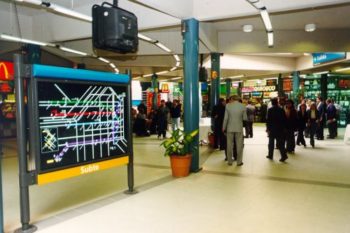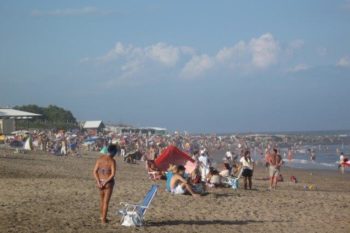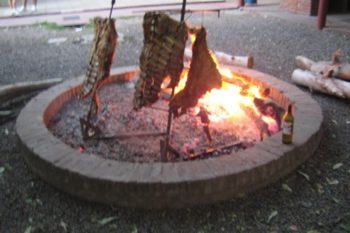Recently on PocketCultures, we have featured collaborative posts to reflect the varying experiences of our contributors in different countries. These include Superstitions around the world and one of our most popular posts, Kiss, hug or shake hands?
This month, we asked our contributors from around the world to tell us about a typical school day in their country.
United Kingdom

Photo credit: shaindlin
Lucy Chatburn wrote:
Children in the UK usually start going to school just before their fifth birthday. They attend primary school until the age of eleven, and then secondary school until the age of sixteen or eighteen. At primary school the typical day is from 9am to 3.15pm, with slightly longer days in secondary school.
The school year starts in September and finishes in July, with six weeks of summer holiday in between. There are three terms with breaks for Christmas and Easter.
Most schools have a uniform, which might be a sweatshirt or blazer, t-shirt with the school’s logo, plain grey or black trousers for boys and skirt or trousers for girls. Because the weather is usually cold, most children wear a thick coat to school, which they hang up outside their classroom. They put it back on again at playtime so they can play outside without getting cold.
All school children in the UK learn from the same curriculum, which includes numeracy, literacy, science, ICT (computers), music, geography, history and religion (covering all major world religions).
When I was at school there were no foreign language classes until we started secondary school aged eleven. Recently, language learning in primary school has been encouraged and some schools begin teaching at seven years old. The languages are usually French or German. The central London school where my sister teaches has many children whose parents have moved to Britain from elsewhere – Bangladesh, Turkey, Somalia and various other countries. For many of them English isn’t their first language, so when they come to school they don’t speak fluently and some don’t speak English at all. They soon pick it up though!
Spain
Marta Garcia wrote:
In Spain, children must attend school from 6 to 16 years old, by law, but, as both parents usually work full-time, schooling usually starts at 3 years old. Many babies start kindergarten as soon as their mothers resume work after their maternity leave. So, many babies start kindergarten when they are four months old from 9am to 5pm.
The school term begins in September and finishes at the end of June, so children have more than two months of summer holidays, which is great for the kids but very complicated for the working parents. Many children go to summer camps, specially focused on playing sports and practising their English language skills. Some children spend time with their grandparents instead of going to summer camps. Grandparents play an important role, as they usually take care of their grandchildren until their parents come home.
Schools are public, prívate or concertadas (a mixture of prívate and public features). Children usually have lunch at school: first course (soup, pasta, rice or vegetables), second course (fish or meat) and a piece of fruit or yoghourt.
After school activities are very common. The most popular in Spain is football, but the offer is wide: basketball, volleyball, handball, dance, judo, theatre, guitar, photography, radio, and hiking among many different options. It’s very common that children learn to swim one day per week during the school hours.
English is the foreign language taught in the majority of schools, but some offer French, Italian or German classes, too. Lately, some schools offer Chinese, as they consider it the language of the future.
Argentina

Photo credit: Ana Astri O’Reilly
Ana Astri-O’Reilly wrote:
In Argentina you can choose from a wide variety of types of schools, both state-run and private. State-run schools are free and quality of tuition ranges from dodgy to excellent. Some private schools were originally founded by a specific community of immigrants (English, French, Italian, Basque, German) for their children but anyone can attend now. One of my nieces goes to a German-Argentinean school and we’re not of German descent. There are many different religious schools, including Jewish, Adventist, Protestant, Maronite, Catholic.
I went to a Catholic school called Santo Domingo run by Dominican nuns. It was girls only but they moved with the times and now it’s co-ed. Bummer! I missed that by a few years. I have to say I had a great time at school (the nuns notwithstanding) and some of my closest friends are from that time.
We don’t spend the whole day at school: you choose the shift, morning or afternoon. Morning shift is anywhere between 7 and 7:45am to 12.30 or 1pm. If you’re in secondary school you may stay until 2 pm on some days or come back in the afternoon for extra classes. We study maths, Spanish grammar and literature, Argentinean and world history and geography, a foreign language (usually English), chemistry, physics, music, art, civic education, religion (in my case) and other subjects depending on the school.
Costa Rica
Nuria Villalobos wrote:
In 1869 Costa Rica became one of the first countries in the world where education became both free and compulsory. Nowadays Costa Rica has a 95% literacy level and even the smallest of towns has its own school.
The school year in my country runs from February to December in the public education system. Students have vacations for about two months (December and January), which turns out to be our summer, as well as two weeks off in July. Primary education lasts six years, while high school education might be five or six years, the first being academic and the latter technical or professional. There are also private schools, which use an American, European or Japanese system.
Students in public schools wear an official uniform in order to lessen social and economic distinctions among them. In elementary school, little boys wear dark blue pants or short pants and a white shirt; girls wear a dark blue skirt or pants and a white shirt. In high school, students wear dark blue pants or skirts, and a light blue shirt. In some high schools the colors of the uniform are different, like in the Technical High School I attended, where we wore burgundy pants and skirts, and beige shirts.
In all public schools, students have to take subjects such as Math, Science, Social Studies, Spanish and two foreign languages (English and French). They also take Art, Music, Physical Education and Computer Science classes. A normal school day starts at 7am. and can finish between 1 and 5pm, approximately. Sometimes students go to class either in the morning or in the afternoon.
Students in elementary and high schools are required to pass comprehensive tests on all subjects studied during the five or six years. The high school diploma is needed for admission to universities, either public or private.
United States
Sean Oliver wrote:
In the US, school typically runs from late August or early September, though early June, with a long break in the summer, one week at Christmas, and one week in the spring. This is changing in some places (like Chicago), where they have shortened the summer break, and added longer breaks throughout the year. I’m not entirely sure, but I think the long summer break was originally intended to make the “farm kids” available for work on the family farms during the summer.
The weather will vary greatly depending on your location. In the Midwest where I’ve lived most of my life, the summers are hot and humid (up to 30C), and the winters can be very, very cold. Where I went to school (pre-college), the superintendent of schools can cancel classes because of too much snow, ice on the ground, or for extreme cold, but never for heat, even if there is no air conditioning (common in many public schools). I remember a day in February one year where they had to send us home at 11:30am because the water main into the city froze (it was about -23C).

Photo credit: taylor library
The typical school year has two semesters, divided by Christmas break. Kids begin Kindergarten around age 5, and finish up primary school in grade 5 or 6 (ages 10-12). Middle school is a combination of grades 6-9, depending on the state and district (it was 7-8 for me). Usually school is 8 or 8:30am to 3 or 3:30pm. Activities such as school-sponsored sports, theater, academic challenge or band follow immediately afterwards. Education in the US is the responsibility of the states, which makes regional differences pretty wide. Different states even use different textbooks.
I was a “latchkey kid” after age 11 or 12; I would walk from the bus to my house, and do homework or watch TV until my parents got home around 5:30 or 6pm. My brother attended an after-school activities program until he was about 14. When I went to school the 6th, 7th, and 8th grades all had their own building, but as my hometown has lost 25% of its population, two of those old buildings have closed. The State of Ohio has a program where you can leave high school after your second year (high school years: Freshman, Sophomore, Junior, Senior) to attend a state-funded college, where you’ll take similar classes, which count towards both high school and most college graduation.
Uniforms were unheard of in public schools when I was entering, but have become much more common. I believe the school where I grew up requires them now. Given that a lot of conversations in school seemed to revolve around what clothes/shoes/bookbag you had, and whether it was cool or not, makes them seem like a good idea.
Like anything else in America, you pretty much get the education you pay for, unless your district has an advanced program (like mine did), or you win a lottery to get into a charter school. The vast majority of school funding in the US is based on local property taxes, so if you live in a poor district, your school is not likely to have the resources that a school in a rich district will. There are many private schools, and some do offer scholarships, but there is no guarantee you’ll get a quality education if you don’t have the money to pay for it.
Romania
Carmen Cristal wrote:
Flowers, balloons, teachers, excited parents and grandparents dressed as for special occasions, “cadets” (for them the first school day will be unforgettable!) and “older” pupils anxious to meet their colleagues and exchange impressions about their summer holiday. This is how school usually begins in Romania, every fall, in the middle of September.
In my country the education in public schools is theoretically free; the duration of compulsory education is 10 years (from age 6 to age 16; grades 1 to 10). It includes Primary School (4 years) and Lower Secondary (6 years), followed by Upper Secondary (2-3 years). After the twelfth year or education a certificate/diploma is awarded based on the baccalaureate exam. The school year is divided in two semesters and a number of holidays. This year for example, the first semester is September 13th to January 28th and the second is February 7th to June 17th. Schools will have five holidays: Christmas, Easter, summer and three shorter ones.
Practically, new school books are offered free only for children in the first grade and there are a lot of financial “contributions” which parents have to pay during the whole year (like school fund, grade fund, extra school reading books, presents for teachers on special occasions like Martisor, the 8th of March, Christmas, Easter and so on and so forth).
They also must buy a uniform, as more and more schools require one lately, which sometimes is not very cheap. And we mustn‘t forget the school bag, a lot of copy-books (for Literature, Math, Biology, Drawing, etc), a pencil box full equipped, transportation, special sport equipment, educational software and many more. And, of course, the daily sandwich, because most of the schools don‘t provide meals for the children. But, by law, pupils in 1st-8th grades receive every day a bread roll and a little milk or yoghurt box.
From 1st to 4th grade lessons are taught by only one teacher for most of the subjects; there are additional teachers only for specialized subjects (for example Foreign Languages or Computers). From the 5th grade there is a teacher for every subject. Since the fall of communism in 1989, Romania’s education system has experienced many changes. This is a brief description of what is now a very complex subject.
Australia
Rebecca Kinsella wrote:
The climate in the southern hemisphere means that school Summer holidays run from late December to late January and then the new school year starts from here. In Victoria, our school year has four terms of 9 to 11 weeks, with two weeks of holidays between each term. Usually, children begin primary school around age 5 and finish in grade 6, aged 12. A typical school day is from 9am to 3:30pm.
I have two younger brothers, Lachlan, aged 9 and in grade 3, and Maclain, aged 7 and in grade 2. They attend a local government run (public) primary school and as my parents both work full-time they’re enrolled in a before and after school care program. Many schools also have a “walking bus” system, where volunteers (usually parents) walk a specific route to and from school each morning picking up the children along the way.
The harsh Australian climate means that many schools, including theirs, have adopted a sun protection policy and a “no hat, no play” rule. This means that if they don’t bring their sun hats to school in Summer, then they’re not allowed to play outside. Most schools require students to wear a uniform too.
In addition to Maths, English, Arts and Science, they are learning about sustainability and the environment. Each week they have music and dance classes and attend swimming lessons for one term each year. Languages other than English (LOTE) studies are offered at most schools. They are learning Indonesian and other schools in our area offer Mandarin and Japanese.
Did you share any of these experiences during your school years? Tell us about a typical school day in your country…
**
Follow PocketCultures on Twitter or join us on Facebook to learn more about cultures from around the world.





Reading the US and Australian definitions of public school reminded me of something I didn’t write about – in the UK a ‘public school’is one you have to pay for, as is a ‘private school’. The alternative is a state school, which is funded by the state. Very confusing!
thanks for sharing this. It’s like touring around the globe, meet people from different schools and I like it. Even though it’s possible for me to visit each country but I am overwhelmed by this post;0
We are a group of volunteers and starting a new scheme in our community. Your web site offered us with valuable info to work on. You’ve done a formidable job and our entire community will be grateful to you.
Thank you alot this helped me with my feature article.
P.S. This site is awesome.